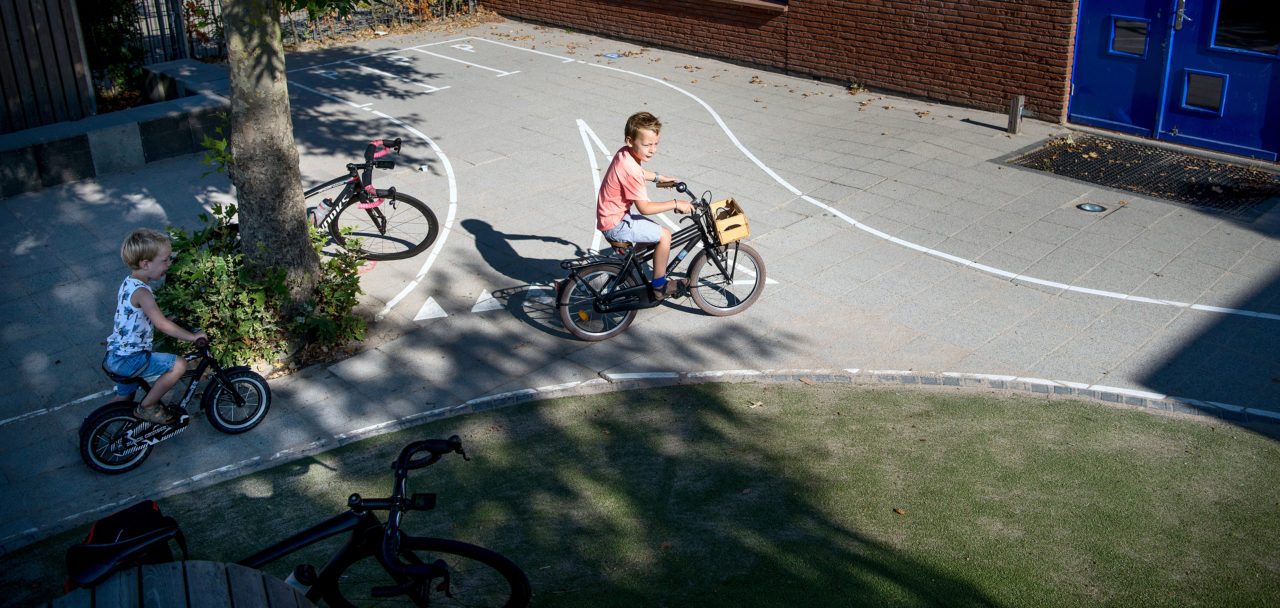In 2040, an entire family of bicycles is riding around, which means there is a suitable bike for virtually all Dutch people and all situations, and the car has lost its main appeal. The cyclists that use this FietsFamilie experience cycling happiness. That means they feel fast, safe and comfortable when they are out and about on their bike.
In the Fietsvisie 2040, we illustrate our dream for the future and the steps we need to take to realise it.
We look at the following six main lines for this:
1. STOP principle is paramount
Stappen (steps), trappen (pedalling), ov (public transport), personenwagen (passenger car): that is the order in which the mobility policy takes shape in 2040, even at the government level. This STOP principle, as the Flemish call it, is paramount. When designing solutions on the street, but also when it comes to the proportion of the investments that are involved. We choose active (cycling, walking) and sustainable (cycling, walking, public transport) mobility over car mobility.

2. The bicycle becomes a family
In 2040, we not only see the familiar (electric) bicycle on the street, but an entire FietsFamilie of cargo bikes, transport bikes, tricycles, speed pedelecs, velomobiles, recumbents, adapted bicycles and people with a handicap, rickshaws, bicycle taxis, covered bicycles, etc. All these vehicles, which requires your muscles to move, are members of the FietsFamilie and welcome with the Fietsersbond. This motley procession dominates the streetscape in 2040 and has taken over the dominant position of individual passenger cars thanks to its diversity and adaptability.
3. Cycling happiness for all cyclists
The Fietsersbond is committed to making cycling happiness possible for all cyclists, everywhere and for everyone. Cycling happiness means people feel comfortable on their bikes because they can cycle fast, safely, stress-free and comfortably. Every child has the right to a bicycle and the right to learn how to cycle in a safe environment. The bicycle network is so attractive that everyone is comfortable using it day and night.

4. Low speeds and different safe cycling route networks make room for diversity
In 2040, there is a safe and comfortable place in the road for the entire FietsFamilie. This is possible because the maximum speed for vehicles has been lowered to 30 kilometres per hour in the built-up area and to 60 kilometres per hour outside those areas on non-motorways. The layout on the street has been adjusted and all vehicles with an (auxiliary) motor have an intelligent speed assistant, which means speeding is no longer possible.
Three route networks for bicycles have been developed and realised, which makes conflicts within the FietsFamilie a thing of the past: a peaceful network for vulnerable cyclists, the main net for bicycles and a new route network that is mainly suitable for heavy and fast bikes. The diverse cycling network, sustainability, safety and health have become the focal point for policy and investments in the mobility world. This has decimated the number of bicycle accidents on the road.
5. The bicycle is an effective tool for the UN sustainability agenda
The bicycle unmistakably contributes to the realisation of many of the goals of the United Nations Sustainable Development Agenda. In addition to being a pleasant way to get from A to B, cycling has also become an important tool for making our country more liveable, sustainable, healthier and more accessible. The relatively low costs that must be incurred to improve the cycling climate are offset by enormous social benefits in the areas of health, poverty reduction and the environment.
The health of Dutch people has strongly improved in 2040 compared to 2018. The epidemic of lifestyle diseases due to a lack of exercise has been solved because people have started cycling more and more. Firstly, because more governments have started using walking and cycling as a central element of their spatial and mobility policy, but also because employers and employees have switched en masse to (stimulating) the bicycle, because they want to contribute to the government’s new health and climate policy.
The air quality in the Netherlands has also improved significantly. Because people drive less, but also due to the country’s new infrastructure and the transition to new energy sources. Scientists and policymakers from all over the world come to see how we achieved that in the Netherlands.
6. The Fietsersbond is for all cyclists

The Fietsersbond is a diverse community of cyclists who exchange experiences, meet each other, help each other and stand up for each other. The Fietsersbond is there for everyone who moves on a member of the FietsFamilie: to work, to school or just for fun. The members of the Fietsersbond, no matter how varied in their views, feel connected by a number of basic principles, recorded in a manifesto. The members propagate these principles among themselves, but also toward governments, market parties and other cyclists. The most important underlying principle is that the Fietsersbond stands for inclusive and sustainable mobility for everyone. Young and old must be able to travel independently, safely and comfortably. This also means that the Fietsersbond always puts the interests of the most vulnerable cyclists (children, elderly, people with disabilities) first. After all, the Fietsersbond is the only organisation that represents these interests. This also means the Fietsersbond always looks for solutions when problems occur.
To increase the support for our work and achieve our objectives, the Fietsersbond is positioning itself more emphatically as leader in the field of inclusive and sustainable mobility. The Fietsersbond does this by protecting the interests of the cyclists and the FietsFamilie. To achieve the other objective, the Fietsersbond initiates collaborations with organisations that protect the interests of walkers, public transport, clean air, health, attractive cities and landscapes. A good example of such a collaboration is the benchmark for sustainable, active and healthy cities we created in 2018 with Longfonds, Natuur en Milieu, MENSenSTRAAT, Milieudefensie, Rover and Wandelnet.

